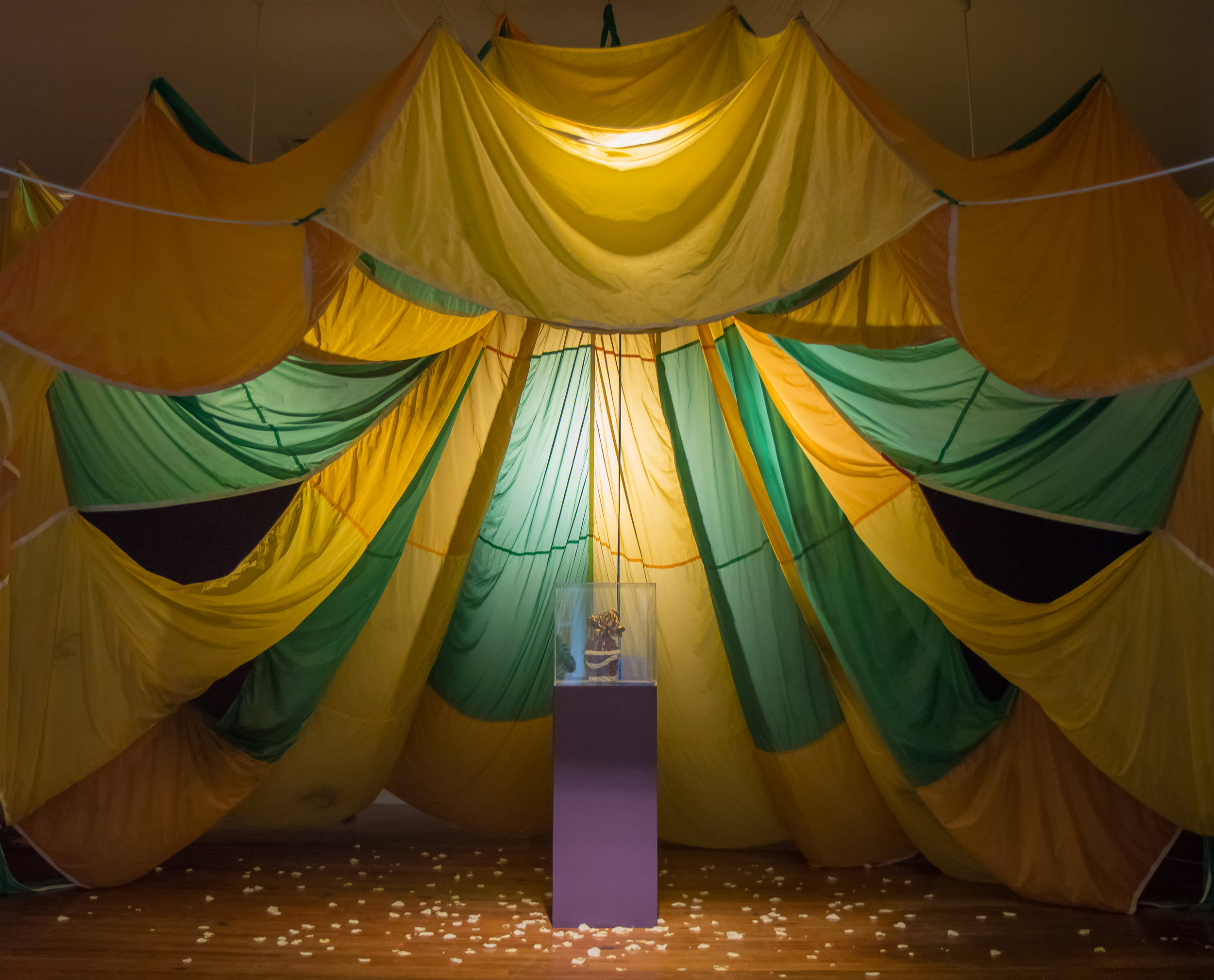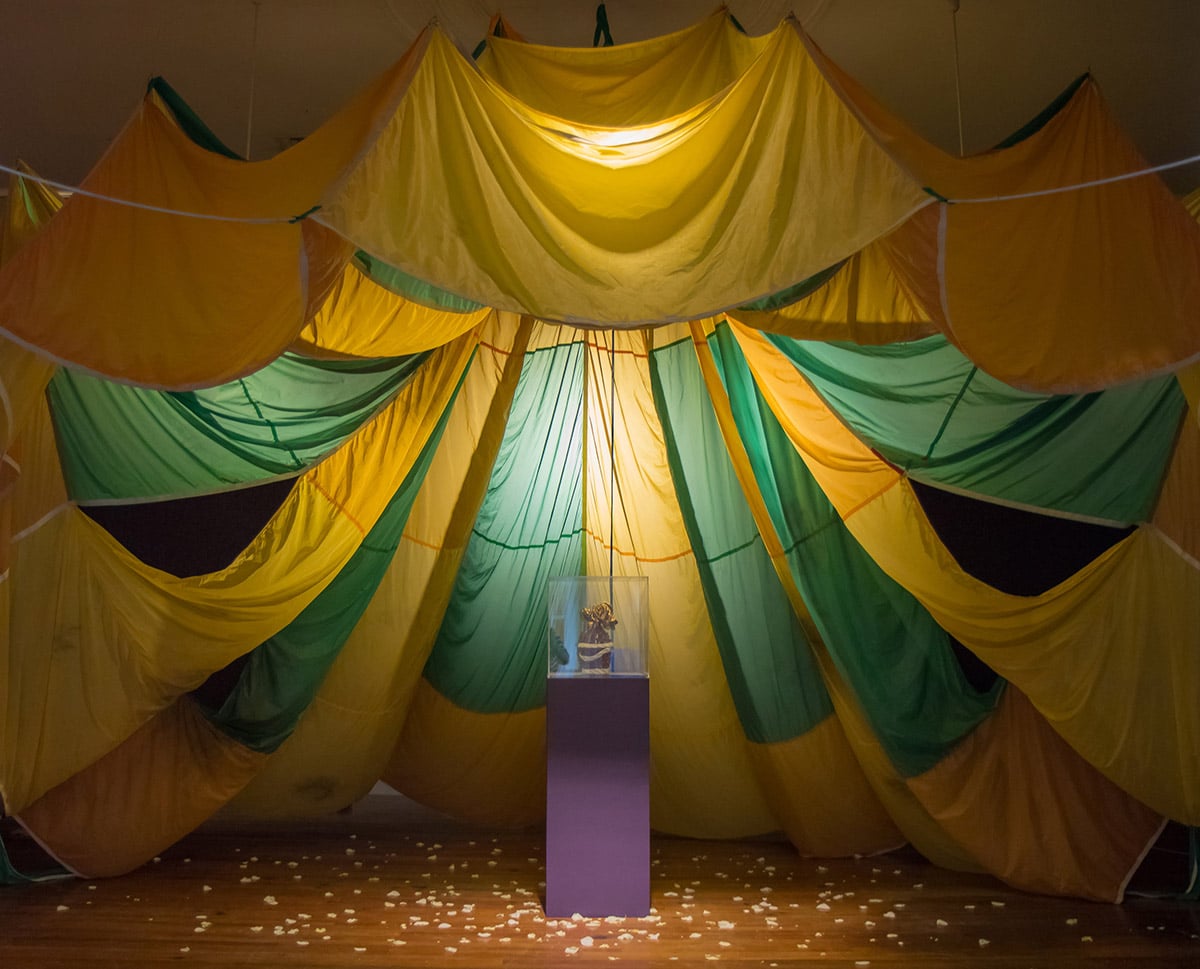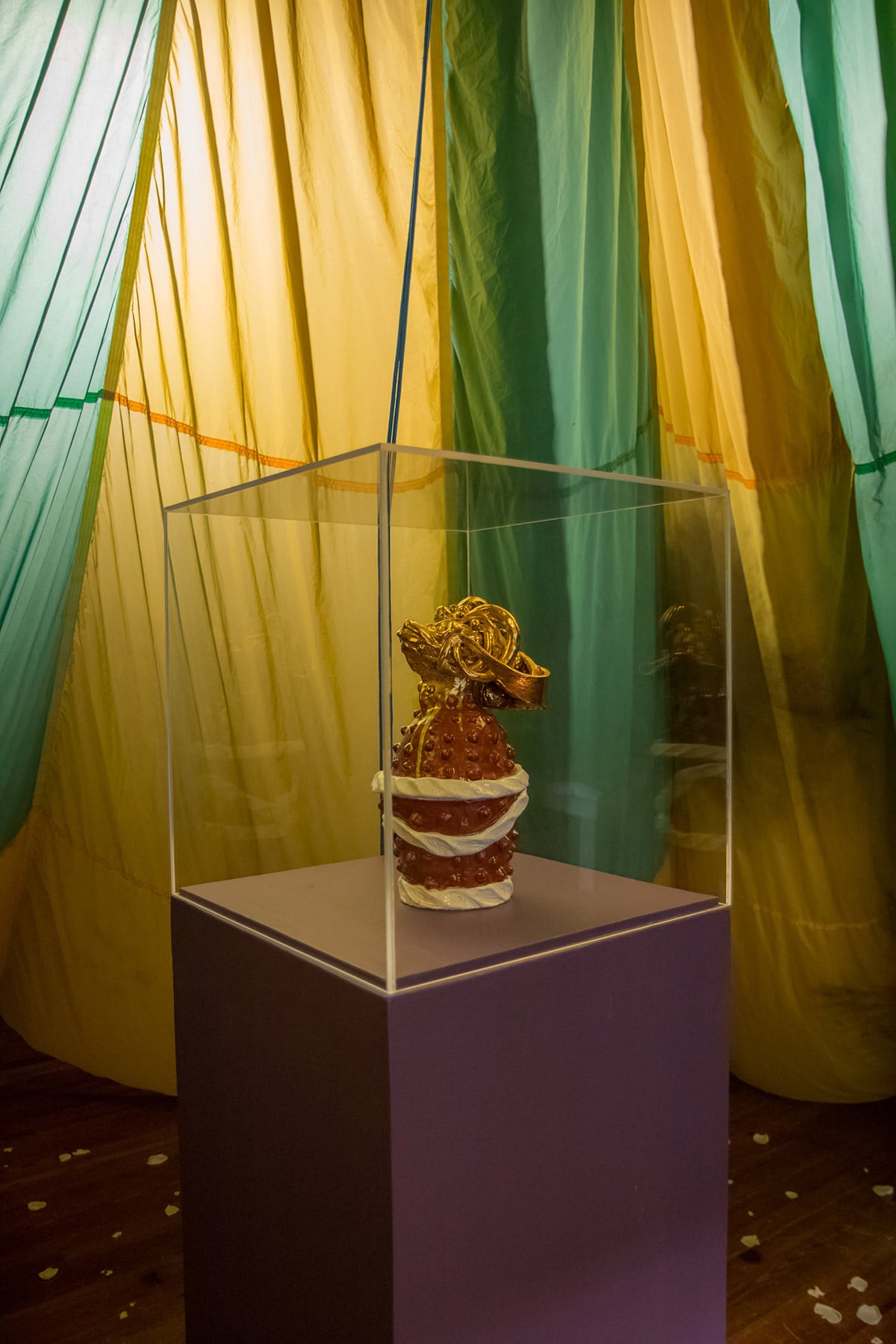
By Natalie Willis
“i learn urgently
the architecture of loss
then find you again.”
― Warsan Shire
Lavar Munroe’s “Memorials” series is an exercise in the architecture of loss, of remembering, and the residue of life we leave long after we are physically gone from this world. A parachute, a hand-made urn, and flowers are an unlikely pairing but help to braid together the strands of the story of a man’s life, but they also offer us a thread between worlds, between countries, between lives, and between times.
Munroe–proud of his upbringing and regular reunions with the Grants Town community where he still holds a studio–spends much of his time these days travelling. Not unlike the parachute shown in “Return: The Magic Flight” (2018), he is uprooted, but he often finds his way back to the solid soil of this historic settlement in Nassau. The “nation’s navel” that is Bain and Grants Town have produced a number of historically significant figures in Bahamian history, and Lavar is well on his way to being a key fixture in Bahamian art history for years to come, if his current 10 year survey at the NAGB (with the proud and proclamatory title “Son of the Soil”) is any indication.
The self-proclaimed “trickster” artist worked on his hustle from a young age, the strong affinities to work and the “grind”, Munroe claims he always intended to be a successful artist, and his work ethic shows this. Whether it be toiling in the studio, networking like he invented the word, or going door to door in his youth to sell his work, he has a dedication that is hard to deny and even harder to stop should anyone be foolish or wicked enough to try it. But his work, outside of trickery and leading audiences unknowingly into bizarre and beautiful and disconcerting content, also serves as a way to reconcile identity, and further still to reckon with life’s behemoths of emotional tribulations: grief and loss.

“Return: The Magic Flight” (2018). Lavar Munroe’s “Memorial” series of posthumous collaborations with his late father.
Of his memorial series, utilising the material traces of his father’s life on this earth, Munroe offers that they “function both as homages and posthumous collaborations with my late father. The inception of these works came about due to prior plans to collaborate with my father two years before his death. Our intentions were to better understand each others professions, with the deeper interest in using both of our practices to metaphorically connect with my deceased mother.”
Having lost his mother quite early on in life, his father in his adulthood, and growing up in a historic community criminally underserved by the state, suffering from all social ills imaginable, loss is no stranger. It is a part of life itself, but in spite of all this the universal truth is that nothing can prepare us for the loss of a beloved parent. Still, we find ways to cling to those traces, still vibrating with the energy of a life lived, that we can find here. The sweat and oils of skin imprinted into fabric, stains from daily use, all of this is present in Munroe’s father’s parachute. The elder Munroe was a parasailing instructor, who had, perhaps in an act of life’s foretelling of our stories (not unlike the dreams the artist had foretelling his father’s passing), expressed his wish to travel with his son as he exhibited his work and worked in the US.
For Munroe, “The trickster sensibility is definitely at play in these works. The notion of shapeshifting, of time shifting, of being neither here nor there. But also, having a presence of different hands. With Jackson Burnside, his painted gestures became a collaboration with the stuff I’m doing with dad, his plaits, his stains, his fingerprints, his patchwork within the parachute. All these things to me are very relevant and are artworks within themselves. I think where I take a twist with it, is that I think of them as being quite literally involved, as I’m making this in my mind they are making simultaneously. It’s like you working with someone but they finish before you and you have to catch up. That’s how I’m thinking about this.”
Parasailing is a particular way of moving, not quite travel certainly, but not quite not so either. It is seemingly limited in geographical distance, but for a moment it offers us a way to travel out of our lives whilst living in the same space by way of being suspended – above the repetition of our everyday, somehow transcended out of it thanks to being a few feet in the air. Parachutes themselves give us a moment to consider transcendence, being above, but also, and perhaps most importantly, denote a feeling of safety – all things that most of our parents wish to give to us. Caring parents wish us to be above them in some way, flying higher and better than they ever could as we ourselves become a living, bleeding, moving obituary to their memory. They also wish to offer us safety from falling, from not slipping from the great height they want us to start with in life.

“Return: The Magic Flight” (2018). Lavar Munroe’s “Memorial” series of posthumous collaborations with his late father.
The dramatic nature of the senior Munroe’s parachute being suspended renders it almost womb like as it holds the urn of his ashes immediately below, sheltered in arms made of green and yellow fabric. There is an appropriate theatricality to the presentation that fits with the way we enjoy remembering people in The Caribbean – we love fanfare, we love loud. But it is also soft, the wind is out of the sails as the parachute is at rest, and in thinking of the intentions for collaboration with his father before his death as a way to also remember his mother, the parachute becomes a sort of self-reflexive, self-referential pieta in grieving.
As Michelangelo’s pieta shows the Virgin Mary encompassing the murdered Jesus in her arms, there is something of Munroe’s late father and mother in this, encompassed in his tender homage, as their energies encompass each other in this collaboration that collapses the seemingly unending distance of loss that time gives us. The pieta is a moment of melange and mixing – of life mixing with dead, of grief mixing with love and loss. It is also a moment for us to remember our own mortality, as the ultimate memento mori – even those we find immortal and untouchable, as so many children do with their fathers, can and must still leave us in this world.
Munroe’s memorial gives us all this, but his reconvening with the dead renders time’s power in keeping us from our loved ones useless as he is still able to fulfil his promise to his father. They are still collaborating, albeit posthumously, and his father is still travelling with him as he makes his work. His father has now convened with him in the US as he works, and will continue to travel with his son as he has with his homecoming here at his national gallery for art that exists at the threshold of his community. The man is still present in the small ways his body can still be present in ash and sweat, but his spirit is present in these works as much as Munroe’s sincerity.
The family flies, suspends, moves, and builds. With each iteration the profession of the meeting point of grief, love, and moving past that grief, as well as the radical act of remembering, grows and builds out the billowing architecture for Munroe’s personal and yet universal understanding of the mechanics and power of love and loss.
Lavar will return home yet again in support of an artist talk on Friday, November 16th starting at 6pm, followed by a scavenge and sculpt workshop on Saturday, November 17th. The artist’s talk is free and open to the public, while the workshop is $25 for adults and $10 for students and kids.